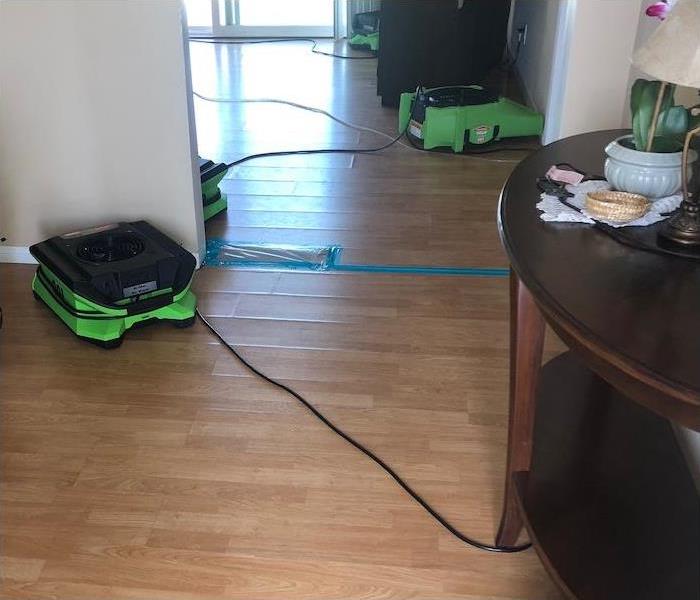The Importance of Drying Wet Items after Azusa Water Damage
4/13/2023 (Permalink)
SERVPRO Dries Contents and Structure During Azusa Water Restoration
If you have ever suffered water damage in your home, you know how quickly liquid spreads and soaks into materials. Even a simple kitchen spill or a leaking faucet can swiftly lead to wet carpets, damaged appliances, or sodden wallpaper. Drying wet items as soon as possible is key to water damage restoration.
SERVPRO technicians are waiting to assist after water damage in Azusa. The sooner we arrive, the sooner we can dry your home. Call us as soon as you can. We are here 24/7.
What Steps Do We Take to Deal with Water Damage?
The first thing we must do is remove excess liquid.
A mop might do the trick in the case of a small spill or leak. However, we need to use more powerful equipment when standing water is present.
We use free-standing or truck-mounted pumps to draw water out of your house. These pumps are equipped with a heater, pump, and vacuum system and are also used for cleaning carpets and upholstery. During water evacuation, we only use the vacuum action.
Free-standing pumps let us access multiple levels of your home. Truck-mounted pumps are less flexible but can handle larger volumes of liquid. Truck-mounted machines also have their own power supply, so we can use them even if there is no power in your house.
Why Drying Matters During Restoration
Effective extraction is the first step in remediation. However, we are still left with a damp structure and contents once we finish extraction. We need to dry wet items to prevent further damage, mold, and smells, leaving your home “Like it never even happened.”
Our technicians decide on the best setup for drying your home, including:
- Setting up fans and air movers to create evaporation
- Using dehumidifiers to draw moisture out of the air
- Bringing in axial fans if needed
Equipment positioning is critical. We can use air movers to direct airflow across the floor, into the air, or up towards the ceiling. Air movers encourage water to evaporate from wet surfaces. We can even position them to create a vortex of airflow that gets behind baseboards and takes care of damp inside wall cavities.
The best place for dehumidifiers is in the center of the water-damaged area. As the air movers increase moisture evaporation, the dehumidifiers draw moisture from the air. The air movers must not blow air across the dehumidifier coils because this prevents the dehumidifier from working efficiently.
We have both refrigerant and desiccant humidifiers at our disposal. Refrigerant units can remove more significant amounts of moisture per day, which is helpful for larger incidents. Desiccant units work better at lower temperatures: Even Azusa can get quite cool at some points of the year.
What About Deodorization?
There can be multiple odor sources in a water damage situation, and without treatment, the damp smell can linger for days. Odor sources include:
- Wet rugs or drapes
- Damp patches behind furniture
- Moisture damaged drywall.
Air scrubbers remove odors from the air and pump out fresh air in their place. Ozone machines generate ozone molecules that react with odor-causing particles and reduce the smell. These machines require vacated premises since ozone is a hazardous gas that is typically used following house fire extinguishing. ULV foggers generate a fine mist of odor-fighting products that we can direct into nooks and crannies or use on upholstery and furniture.
Swift action is best in cases of water damage. Do not delay. Call SERVPRO of Azusa / Covina at (626) 387-4111 for assistance.

 24/7 Emergency Service
24/7 Emergency Service
